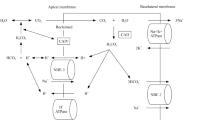Abstract
Renal tubular acidosis (RTA) is essentially characterized by normal anion gap and hyperchloremic metabolic acidosis. It is important to understand that despite knowing the disease for 60–70 years, complexities in the laboratory tests and their interpretation still make clinicians cautious to diagnose and label types of tubular disorder. Hence, we are writing this mini-review to emphasize on the step wise approach to RTA with some understanding on its basic etiopathogenesis. This will definitely help to have an accurate interpretation of urine and blood reports in correlation with the clinical condition. RTA can be a primary or secondary defect and results either due to abnormality in bicarbonate ion absorption or hydrogen ion secretion. Primary defects are common in children due to gene mutation or idiopathic nature while secondary forms are more common in adults. We are focusing and explaining here in this review all the clinical and laboratory parameters which are essential for making the diagnosis of RTA and excluding the extrarenal causes of hyperchloremic, normal anion gap metabolic acidosis.


Similar content being viewed by others
References
Rodriguez-Soriano J, Edelmann CM Jr. Jr Renal tubular acidosis. Annu Rev Med. 1969;20:363–82.
Pines KL, Mudge GH. Renal tubular acidosis with osteomalacia; Report of 3 cases. Am J Med. 1951;11:302–11.
Elkinton JR. Renal acidosis. Am J Med. 1960;28:165–8.
Morris RC. Renal tubular acidosis. Mechanisms, classification and implications. N Engl J Med. 1969;281:1405–13.
Peters M, Jeck N, Reinalter S, et al. Clinical presentation of genetically defined patients with hypokalemic salt-losing tubulopathies. Am J Med. 2002;112:183–90.
Maddox DA, Deen WM, Gennari FJ. Control of bicarbonate and fluid reabsorption in the proximal convoluted tubule. Semin Nephrol. 1987;7:72–81.
Rodríguez-Soriano J, Boichis H, Stark H, Edelmann CM Jr. Proximal renal tubular acidosis. A defect in bicarbonate reabsorption with normal urinary acidification. Pediatr Res. 1967;1:81–98.
DuBose TD Jr, Good DW, Hamm LL, Wall SM. Ammonium transport in the kidney: new physiological concepts and their clinical implications. J Am Soc Nephrol. 1991;1:1193–203.
Halperin ML, Goldstein MB, Richardson RM, Stinebaugh BJ. Distal renal tubular acidosis syndromes: a pathophysiological approach. Am J Nephrol. 1985;5:1–8.
Hamm LL, Hering-smith KS. Acid-base transport in collecting duct. Semin Nephrol. 1993;13:246–55.
Fry AC, Karet FE. Inherited renal acidosis. Physiology. 2007;22:202–11.
Del FA, Cappariello A, Teti A. Genetics, pathogenesis and complications of osteopetrosis. Bone. 2008;42:19–29.
DuBose TD Jr. Hyperkalemic hyperchloremic metabolic acidosis: pathophysiologic insights. Kidney Int. 1997;51:591–602.
Rodriguez SJ. Renal tubular acidosis: the clinical entity. J Am Soc Nephrol. 2002;13:2160–70.
Kraut JA, Madias NE. Serum anion gap: its uses and limitations in clinical medicine. Clin J Am Soc Nephrol. 2007;2:162–74.
Dyck RF, Asthana S, Kalra J, West ML, Massey KL. A modification of the urine osmolal gap: an improved method for estimating urine ammonium. Am J Nephrol. 1990;10:359–62.
Kim GH, Han JS, Kim YS, Joo KW, Kim S, Lee JS. Evaluation of urine acidification by urine anion gap and urine osmolal gap in chronic metabolic acidosis. Am J Kidney Dis. 1996;27:42–7.
Walsh SB, Shirley DG, Wrong OM, Unwin RJ. Urinary acidification assessed by simultaneous furosemide and fludrocortisone treatment: an alternative to ammonium chloride. Kidney Int. 2007;71:1310–6.
Kim S, Lee JW, Park J, et al. The urine-blood PCO gradient as adiagnostic index of H+-ATPase defect distal renal tubular acidosis. Kidney Int. 2004;66:761–7.
Gonzalez SB, Voyer LE, Quadri SCB, et al. Determination of urinary bicarbonate with the Henderson–Hasselbalch equation. Comparison using two different methods. Pediatr Nephrol. 2004;19:1371–4.
Conflict of interest
The authors have declared that no conflict of interest exists.
Author information
Authors and Affiliations
Corresponding author
About this article
Cite this article
Sharma, S., Gupta, A. & Saxena, S. Comprehensive clinical approach to renal tubular acidosis. Clin Exp Nephrol 19, 556–561 (2015). https://doi.org/10.1007/s10157-015-1119-x
Received:
Accepted:
Published:
Issue Date:
DOI: https://doi.org/10.1007/s10157-015-1119-x




